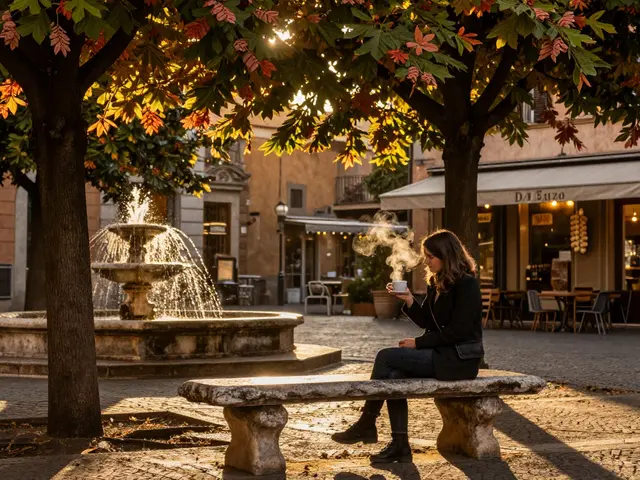Roman romance wasn’t just about roses and whispered poetry—it was creative, bold, and sometimes downright wild. If you think dating feels tricky today, imagine trying to send a secret love message without texting. Romans had their own clever ways of flirting, showing affection, and keeping things interesting even after years together.
They invented some of the first love letters, using coded words and clever messengers to keep things hush-hush. Roman couples went to crazy lengths for a good date—and their feasts weren’t just about food; they were about sparking connections across the table. Even after kids entered the picture (been there, survived that), they had tricks for keeping life spicy without a single dating app in sight.
Curious about how to borrow these ancient moves for your own love life? Even if toga parties aren’t your thing, some Roman romance habits are surprisingly easy to try. Whether you’re looking for better date ideas, ways to reconnect, or just a little inspiration, Roman lovers had answers we can still use.
- What Made Roman Romance Unique?
- Love Letters and Secret Messages
- Roman Dating Rituals You Won’t Believe
- Romance at the Table: Food, Feasts, and Flirting
- Keeping Long-Term Passion Alive—Roman Style
- Modern Love Lessons from Ancient Rome
What Made Roman Romance Unique?
Roman romance stood out because it mixed wild passion and strict rules in a way that would probably make a modern person’s head spin. Back then, marriage and dating weren’t just private business—they were tangled up with social status and family success. Yet, even with parents watching closely, people still found clever ways to flirt and form genuine connections.
The biggest shock? Roman women actually had more freedom than you might guess. Some hosted fancy dinner parties, wrote poetry, and even sparked public scandals with their love affairs. The poet Ovid—think of him like Rome’s OG relationship guru—gave real tips in his book Ars Amatoria (The Art of Love), basically a Roman dating guide. That book was so bold that Emperor Augustus got mad and exiled Ovid for writing it.
It wasn’t always about sneaky affairs or over-the-top gestures. Romans loved the little things: passing secret notes at the baths, sending gifts like flowers or honey cakes, and sharing inside jokes scratched into walls (seriously—some graffiti love notes still survive in Pompeii). Here’s a taste of some eye-opening Roman romance details:
- Engagement rings made of iron—meant to be tough, like the relationship (and not very fancy to show you were loyal, not flashy)
- Courtship often happened at public events like games or festivals, so everyone could see who was spending time with whom
- Even married couples could get away with cute love letters as long as they weren’t too sappy for Roman taste
Here’s a quick look at how Roman couples compared to modern ones in a few areas:
| Romance Element | Ancient Rome | Today |
|---|---|---|
| Love Letters | Passed in secret, sometimes with code | Text, DM, or email |
| First Dates | Public feasts, chariot races | Cafés, movies, apps |
| Gifts | Honey, flowers, carved tokens | Chocolate, jewelry, experiences |
| Love Advice | Poet Ovid, friends, family | Internet, books, podcasts |
Even if you skip the gladiator games, the main thing is that Roman romance always found a way to break the rules without breaking people’s hearts. That mix of rules and creativity shaped how Romans chased love, and some of that energy still shows up in how people date today.
Love Letters and Secret Messages
If you think texting 'I love you' is sweet, wait until you hear what the Romans did. They took letter writing to a whole new level. In ancient Rome, handwritten notes and whispered messages were pretty much the only way to keep a romance going, especially if parents or nosy neighbors were always lurking. It turns out the Romans sent so many love letters and secret notes that archaeologists have found hundreds of them scratched onto wax tablets and pottery shards.
Here’s what makes their letters interesting: they weren’t just about feelings. Roman lovers knew how to mix flattery, jokes, and little codes so only the right person would catch the meaning. For example, letters sometimes used abbreviations or swapped names for Greek gods and goddesses—Venus was code for a girlfriend, Mars for a boyfriend. It’s like a playful inside joke only you and your crush understand.
Cato the Younger, a Roman statesman, apparently checked his daughter’s wax tablets regularly because he knew young couples used messengers—friends or project partners at the local baths—to slip secret notes past watchful eyes. And Pliny the Younger, who actually kept a ton of his own correspondence, even described how he and his wife wrote to each other during the work day, just to stay connected. Sound familiar?
| Fact | Detail |
|---|---|
| Earliest surviving Roman love letter | Written around AD 100 by Claudia Severa to her friend Sulpicia, inviting her to a birthday celebration |
| Famous messenger jobs | Slaves, family friends, even children were often used to deliver secret notes |
| Popular secret codes | God/goddess names, creative nicknames, and riddles |
| Common materials for letters | Wax tablets, papyrus, pottery shards (ostraca) |
Want to try a little old-school Roman romance? Leave a funny note for your partner on the bathroom mirror or slip a quick love letter in their bag. You don’t need a wax tablet—paper (or your kid’s sticky notes) will work just as well. Hide your own little code words or inside jokes. Turns out, a bit of mystery and effort makes the whole thing way more fun—and more personal—than just sending a heart emoji.
Roman Dating Rituals You Won’t Believe
Romans didn’t swipe right, but their dating moves were just as wild—and sometimes way more complicated. Forget “dinner and a movie.” If you lived in ancient Rome, finding a date involved some next-level rituals, rules, and games.
First off, marriages were often arranged, especially among wealthy families. But people didn’t just marry anyone. There were matchmakers for the elite, but public events like festivals were hot spots for flirting if you weren’t already betrothed. The famous festival of Lupercalia, for example, was part dating lottery, part wild party, and totally acceptable for meeting someone new. During Lupercalia, guys would draw the names of women from a jar, and spend the festival paired up. Some couples apparently stayed together long after the event.
Here’s a quick look at some surprising Roman dating customs:
- Chaperones everywhere: Young women, especially in well-off families, were almost never allowed out without a watchful relative or slave following along. Secret notes and stolen moments were the only way for real private chats.
- Love tokens: Rings, bracelets, and even birds (yes, like an actual dove) were popular gifts. These gifts weren’t just cute—they were a way to signal serious interest, almost like saying “I’m in a relationship” on social media today.
- Public flirts: The Roman forum, baths, or big games at the Colosseum were packed with people looking to connect. Guys showed off, girls giggled behind fans, and everyone played their part in the drama.
When it came to weddings, the rituals kept going. There was a strict legal ceremony, where a bride joined her husband’s family by sharing a loaf of bread. Afterwards, the woman was literally carried over the threshold, a ritual we still use today, but it started as a way to avoid “bad luck” or sneaky demons.
| Roman Dating Ritual | What it Meant | Modern Parallel |
|---|---|---|
| Lupercalia Festival Pairing | Festival where men and women were randomly paired | Valentine's Day draws or speed dating |
| Gift Giving (Rings, Birds) | Signaled intent or commitment | Promise rings, love letters, DMs |
| Chaperoned Outings | Protecting virtue and reputation | Group dates, parental supervision |
| Bread Breaking at Wedding | Symbolized entering new family | Cake cutting at receptions |
Even though some Roman traditions seem over the top today, a lot of their rules about dating, gift-giving, and public displays of affection aren’t so different from ours—they just added a few gladiators for extra drama. If you want to borrow anything from their dating playbook, confidence and creativity beat awkward small talk every time. And hey, maybe skip the dove.

Romance at the Table: Food, Feasts, and Flirting
The ancient Romans knew how to turn dinner into the highlight of the day, especially when romance was on the menu. Forget dinner for two—back then, love and connection really fired up around huge banquets. These parties, called convivia, weren’t just about eating. They were social games, ripe for couples to flirt, connect, and maybe even sneak off for alone time. If you picture modern date nights, the Romans did most of it first, but with a lot more drama and way less cutlery.
Experts say food had a special job in Roman romance: it was all about showing off, setting the right mood, and getting creative. Good hosts served oysters, honey cakes, and other foods thought to help spark passion. Wealthier Romans even hired musicians and poets to set the mood—imagine Ewen and me having a string quartet play "your song" over dessert.
"Roman banquets were as much about seduction and social politics as about food. The way you passed the wine or touched a guest’s hand under the table could carry more meaning than any love letter." — Dr. Catharine Edwards, classicist at Birkbeck, University of London
Flirtation at the feast wasn’t all secret glances, though; sometimes it included racy drinking games, cheeky poetry, and friendly competitions to win the last piece of cake. Even seating arrangements mattered! Couples sat close or even reclined on the same couch, which was a classic move if you wanted to let everyone know you were together.
| Famous Roman Feast Flirting Tactics | What Modern Couples Can Steal |
|---|---|
| Sharing sweet pastries with a potential partner | Split dessert after dinner—extra points for feeding each other |
| Passing love notes hidden in napkins | Text flirty messages under the table at group dinners |
| Toasting each other with spiked wine | Make a date night signature drink, toast to inside jokes |
Want to turn your own table into a Roman-style romance fest? Try these:
- Light some candles—the Romans loved oil lamps and dramatic shadows.
- Share your favorite foods instead of keeping separate plates.
- Set silly or intimate challenges during the meal—like one compliment for every new course.
- Add a playful competition; see who can make each other laugh the hardest with a cheesy toast.
At Roman banquets, the food was just the start. It was the connection, laughter, and those little sneaky gestures that made the magic. That’s still the secret sauce for couples now—just skip the togas if they’re not your style.
Keeping Long-Term Passion Alive—Roman Style
Romans totally understood that being together for years doesn’t have to get boring. Instead of letting daily routines kill the mood, they made the effort to shake things up, even after having kids, grandkids, and plenty of arguments along the way.
One big Roman move was shared experiences—favorite entertainment, joint projects, and rituals they stuck to (hello, anniversary feasts). Couples in ancient Rome often went to the public baths together—not exactly our local date night, but it gave them time to chill, talk, and connect away from the stress of home life. They’d even leave little messages scratched into surfaces at the baths for each other. Cheesy? Maybe. But memorable. For some, it worked better than leaving sticky notes on the fridge.
Romans also loved actual date nights—yes, even if it sometimes meant a trip to the local theater or a quick walk to a night market. Public outings were a chance to flirt, notice each other, and do something different. There’s graffiti in Pompeii where couples bragged about their fun nights out. Clearly, they knew it wasn’t just about spending time together, but making that time count. Long-running marriages often marked relationship milestones with gifts, parties, or special dinners (and yes, sometimes these included aphrodisiac foods like oysters or asparagus).
Here’s a breakdown of Roman habits that kept things hot at home:
- Roman romance meant giving each other personal gifts—rings, amulets, or little handmade tokens with sweet messages.
- They wrote love poems or short letters, even after years of marriage, keeping the spark alive with written words (Ovid, the poet, pretty much invented the ancient version of the heartfelt anniversary card).
- Handling chores together, including prepping for parties, was normal. Shared work led to inside jokes and subtle flirting, making everyday life feel less like a drag.
- They kept some surprises up their sleeve; planning something out of the ordinary (like a meal in a new part of Rome) was a trusted habit.
Roman families even tracked how long couples stayed together, and the longer the marriage, the bigger the respect. Archaeologists have found epitaphs from proud spouses, gushing about fifty or sixty years of being together—proof that long-term passion wasn’t rare.
| Roman Marriage Milestone | Modern Equivalent |
|---|---|
| Held a feast after 10, 20, or 30 years | Anniversary parties |
| Gave engraved rings or amulets yearly | Jewelry for special occasions |
| Publicly praised a partner’s virtues in speeches | Social media shout-outs |
You don’t need a toga to borrow these ideas. Schedule regular date nights, try new food together, and find ways to say nice things in writing (even if it's just a text message). Those little rituals, just like back in ancient Rome, can keep your relationship strong and fun much longer than you’d think.
Modern Love Lessons from Ancient Rome
If you’re tired of the usual romance advice, Roman couples have some seriously cool tricks worth stealing. Unlike us, they didn’t have dating apps or DMs. Still, they managed to keep relationships exciting. Here’s what actually worked back then—and how you can use it now.
Romans believed grand gestures made love memorable. Think hand-written notes left for your partner before breakfast or little surprises just because. The Roman romance playbook was all about effort, not perfection. They didn’t wait for special occasions; they looked for small, everyday chances to show care. Real data backs this up today: A 2022 relationship survey found couples that shared regular thoughtful gestures reported being 29% more satisfied than those that didn’t bother much.
- Take turns planning out-of-the-blue dates—Romans loved doing new things together, not just sticking to routine.
- Try writing basic, silly love notes—pretty much like Roman graffiti, but hidden in a lunch bag or slipped into a pocket.
- Use code words or inside jokes—Romans were big on keeping some things secret and playful, even in long-term relationships.
One area where Romans totally nailed it: catching up over food. Forget giant parties; they also just hung out with cheese, bread, or olives, catching up after a long day. Make meals a no-phone zone every so often and actually talk—sounds obvious, but it’s easy to skip when you’re busy with life, kids, or work.
And about fighting? Roman couples argued, sure, but they often found ways to patch things up fast—partly because privacy was rare and nobody liked a big public scene. Today, relationship counselors say couples who talk things through quickly bounce back stronger. It’s less about never fighting and more about the follow-up.
| Ancient Roman Habit | Modern Take |
|---|---|
| Secret Messaging | Notes, inside jokes, and texts that only you two get |
| Daily Shared Meals | Dinner time as talk time (no phones) |
| Small Surprises | Unexpected, thoughtful gestures |
| Quick Conflict Fix | Addressing issues right away, then letting go |
Roman love wasn’t about doing everything perfectly. It was about finding little sparks in daily life, not just holidays. So if you want an upgrade for your own love story, think like a Roman: break routine, get creative, and focus on real connection—one honest, sometimes goofy gesture at a time.









